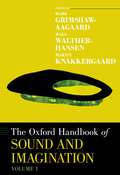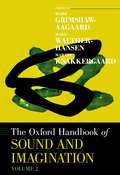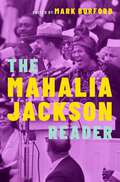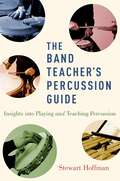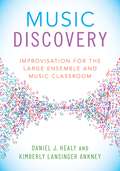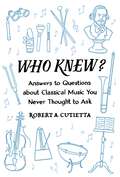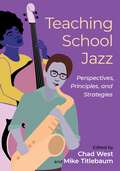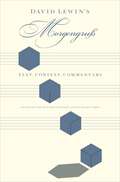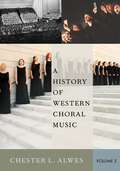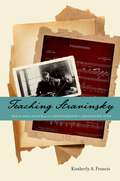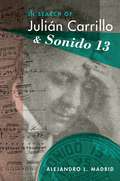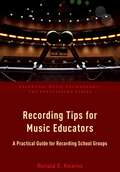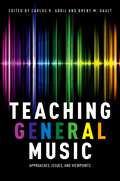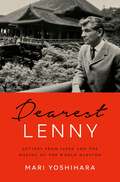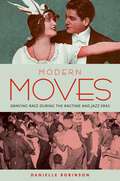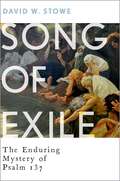- Table View
- List View
The Oxford Handbook of Sound and Imagination, Volume 1 (Oxford Handbooks)
Whether social, cultural, or individual, the act of imagination always derives from a pre-existing context. For example, we can conjure an alien's scream from previously heard wildlife recordings or mentally rehearse a piece of music while waiting for a train. This process is no less true for the role of imagination in sonic events and artifacts. Many existing works on sonic imagination tend to discuss musical imagination through terms like compositional creativity or performance technique. In this two-volume Handbook, contributors shift the focus of imagination away from the visual by addressing the topic of sonic imagination and expanding the field beyond musical compositional creativity and performance technique into other aural arenas where the imagination holds similar power. Topics covered include auditory imagery and the neurology of sonic imagination; aural hallucination and illusion; use of metaphor in the recording studio; the projection of acoustic imagination in architectural design; and the design of sound artifacts for cinema and computer games.
The Oxford Handbook of Sound and Imagination, Volume 1 (Oxford Handbooks)
by Mark Grimshaw-Aagaard Mads Walther-Hansen Martin KnakkergaardWhether social, cultural, or individual, the act of imagination always derives from a pre-existing context. For example, we can conjure an alien's scream from previously heard wildlife recordings or mentally rehearse a piece of music while waiting for a train. This process is no less true for the role of imagination in sonic events and artifacts. Many existing works on sonic imagination tend to discuss musical imagination through terms like compositional creativity or performance technique. In this two-volume Handbook, contributors shift the focus of imagination away from the visual by addressing the topic of sonic imagination and expanding the field beyond musical compositional creativity and performance technique into other aural arenas where the imagination holds similar power. Topics covered include auditory imagery and the neurology of sonic imagination; aural hallucination and illusion; use of metaphor in the recording studio; the projection of acoustic imagination in architectural design; and the design of sound artifacts for cinema and computer games.
The Oxford Handbook of Sound and Imagination, Volume 2 (Oxford Handbooks)
Whether social, cultural, or individual, the act of imagination always derives from a pre-existing context. For example, we can conjure an alien's scream from previously heard wildlife recordings or mentally rehearse a piece of music while waiting for a train. This process is no less true for the role of imagination in sonic events and artifacts. Many existing works on sonic imagination tend to discuss musical imagination through terms like compositional creativity or performance technique. In this two-volume Handbook, contributors shift the focus of imagination away from the visual by addressing the topic of sonic imagination and expanding the field beyond musical compositional creativity and performance technique into other aural arenas where the imagination holds similar power. Topics covered include auditory imagery and the neurology of sonic imagination; aural hallucination and illusion; use of metaphor in the recording studio; the projection of acoustic imagination in architectural design; and the design of sound artifacts for cinema and computer games.
The Oxford Handbook of Sound and Imagination, Volume 2 (Oxford Handbooks)
by Mark Grimshaw-Aagaard Mads Walther-Hansen Martin KnakkergaardWhether social, cultural, or individual, the act of imagination always derives from a pre-existing context. For example, we can conjure an alien's scream from previously heard wildlife recordings or mentally rehearse a piece of music while waiting for a train. This process is no less true for the role of imagination in sonic events and artifacts. Many existing works on sonic imagination tend to discuss musical imagination through terms like compositional creativity or performance technique. In this two-volume Handbook, contributors shift the focus of imagination away from the visual by addressing the topic of sonic imagination and expanding the field beyond musical compositional creativity and performance technique into other aural arenas where the imagination holds similar power. Topics covered include auditory imagery and the neurology of sonic imagination; aural hallucination and illusion; use of metaphor in the recording studio; the projection of acoustic imagination in architectural design; and the design of sound artifacts for cinema and computer games.
The Mahalia Jackson Reader (Readers on American Musicians Series)
Born in New Orleans before migrating to Chicago, Mahalia Jackson (1911-72) is undoubtedly the most widely known black gospel singer, having achieved fame among African American communities in the 1940s then finding a wide audience among non-black U.S. and international audiences after she signed with major label Columbia Records in 1954. The newest entry in OUP's celebrated Readers on American Musicians series,ÂThe Mahalia Jackson ReaderÂplaces Jackson's musical performances and their reception against key changes in 20th-century America, changes that include transformations of the recorded music industry, the increasing visibility of the civil rights movement, a florescence of Cold War-era religiosity, and an explosion of popularity of black gospel music itself. Jackson's career combines parallel tracks as a black church singer and as a national pop celebrity, and makes her one of the most complex and important black artists of the postwar decades. Gospel is a particularly challenging genre to study because of the paucity of sources. BecauseÂof Jackson's celebrity, there is more substantial coverage of her life and work than other gospel artists, but Jackson scholarship is still largely dependent on trade biographies from the 1970s for source material. For this reader, Mark Burford has gone beyond the standard biographies and has drawn from extensive archival research, including in the volume interview transcripts and the largely-untouched papers of Jackson's associate Bill Russell, who kept a journal tracking Jackson's activities from 1951 to 1955. The new sources - in particular Russell's notes - uniquely enable an assessment of the reciprocal relationship between the two careers Jackson pursued, essentially simultaneously: as an in-demand church singer in Chicago, and as a media star for a major network and recording label.
The Mahalia Jackson Reader (Readers on American Musicians Series)
by Mark BurfordBorn in New Orleans before migrating to Chicago, Mahalia Jackson (1911-72) is undoubtedly the most widely known black gospel singer, having achieved fame among African American communities in the 1940s then finding a wide audience among non-black U.S. and international audiences after she signed with major label Columbia Records in 1954. The newest entry in OUP's celebrated Readers on American Musicians series,ÂThe Mahalia Jackson ReaderÂplaces Jackson's musical performances and their reception against key changes in 20th-century America, changes that include transformations of the recorded music industry, the increasing visibility of the civil rights movement, a florescence of Cold War-era religiosity, and an explosion of popularity of black gospel music itself. Jackson's career combines parallel tracks as a black church singer and as a national pop celebrity, and makes her one of the most complex and important black artists of the postwar decades. Gospel is a particularly challenging genre to study because of the paucity of sources. BecauseÂof Jackson's celebrity, there is more substantial coverage of her life and work than other gospel artists, but Jackson scholarship is still largely dependent on trade biographies from the 1970s for source material. For this reader, Mark Burford has gone beyond the standard biographies and has drawn from extensive archival research, including in the volume interview transcripts and the largely-untouched papers of Jackson's associate Bill Russell, who kept a journal tracking Jackson's activities from 1951 to 1955. The new sources - in particular Russell's notes - uniquely enable an assessment of the reciprocal relationship between the two careers Jackson pursued, essentially simultaneously: as an in-demand church singer in Chicago, and as a media star for a major network and recording label.
The Band Teacher's Percussion Guide: Insights into Playing and Teaching Percussion
by Stewart HoffmanThe Band Teacher's Percussion Guide: Insights into Playing and Teaching Percussion is an essential practical resource for instrumental music teachers and band directors. Author Stewart Hoffman, a Juilliard-trained percussionist, performer, private instructor, and former classroom teacher, offers a comprehensive yet accessible and clearly written handbook to help set teachers and students alike firmly on the road to classroom success. In this book, he presents a thorough foundation in snare drum, timpani, keyboard percussion, drum set, and auxiliary and Latin percussion techniques. More than this, he provides practical advice on curriculum and methodology, packing page after page with teaching tips developed through decades of experience. For educators and band directors who want to learn more about percussion instruments and playing techniques, refine their percussion-teaching skills, or set the classroom stage for a more effective and rewarding teaching experience, The Band Teacher's Percussion Guide: Insights into Playing and Teaching Percussion will be a valued resource for discovering: · keys to effective evaluation · how to plan a percussion program and select percussionists · recommended instruments and mallets; repair and maintenance guidelines · lifts and levels, a system that leads students to greater control and a more relaxed snare drum technique · technical exercises for all main and accessory percussion instruments · easily referenced summaries of points to focus on when practicing · guidelines for teaching jazz, Latin and rock drumset Visit the companion website at www.oup.com/us/bandteacherspercussionguide
BAND TEACHER'S PERCUSSION C: Insights into Playing and Teaching Percussion
by Stewart HoffmanThe Band Teacher's Percussion Guide: Insights into Playing and Teaching Percussion is an essential practical resource for instrumental music teachers and band directors. Author Stewart Hoffman, a Juilliard-trained percussionist, performer, private instructor, and former classroom teacher, offers a comprehensive yet accessible and clearly written handbook to help set teachers and students alike firmly on the road to classroom success. In this book, he presents a thorough foundation in snare drum, timpani, keyboard percussion, drum set, and auxiliary and Latin percussion techniques. More than this, he provides practical advice on curriculum and methodology, packing page after page with teaching tips developed through decades of experience. For educators and band directors who want to learn more about percussion instruments and playing techniques, refine their percussion-teaching skills, or set the classroom stage for a more effective and rewarding teaching experience, The Band Teacher's Percussion Guide: Insights into Playing and Teaching Percussion will be a valued resource for discovering: · keys to effective evaluation · how to plan a percussion program and select percussionists · recommended instruments and mallets; repair and maintenance guidelines · lifts and levels, a system that leads students to greater control and a more relaxed snare drum technique · technical exercises for all main and accessory percussion instruments · easily referenced summaries of points to focus on when practicing · guidelines for teaching jazz, Latin and rock drumset Visit the companion website at www.oup.com/us/bandteacherspercussionguide
Music Discovery: Improvisation for the Large Ensemble and Music Classroom
by Daniel J. Healy Kimberly Lansinger AnkneyImprovisation is a boundless and exciting way to experience music, especially for students. Teachers increasingly agree that improvisation is an essential skill for students to learn - however, many are unsure how to productively incorporate it in the classroom. Furthermore, most improvisational practices are centered around jazz, with very little to help even classical and vocal ensembles let alone the general music classroom. Now, in this new book, Daniel Healy and Kimberly Lansinger Ankney offer a practical volume aimed at busy music teachers. Recognizing educators' desire to balance the standard curriculum with improvisational activities, the authors provide 36 activities to incorporate into their everyday music classes and ensemble practices. All activities are flexibly designed in styles ranging from modern classical to pop. Teachers can spend anywhere from 5 minutes to an entire term on a single activity, in a variety of environments and ensembles - concert bands, orchestras, choirs, jazz ensembles, and music technology classes alike can benefit from the practices of improvisation. Aligning improvisation practices with the constraints of the classroom, the lessons focus on key music learning principles (melody, harmony, rhythm, texture/timbre, articulation, and dynamics), allowing students' basic performance skills to develop in conjunction with their improvisational ones. The book also comes with a companion website which provides helpful resources for teachers, including recordings of actual K-12 ensembles performing the improvisation activities. Designed for a wide range of ages and experience levels, Music Discovery: Improvisation for the Large Ensemble and Music Classroom is the first practical guide of its kind, and gives teachers a long-awaited jumping-off point to introduce this playful, thrilling, and vital musical practice to their students.
MUSIC DISCOVERY C: Improvisation for the Large Ensemble and Music Classroom
by Daniel J. Healy Kimberly Lansinger AnkneyImprovisation is a boundless and exciting way to experience music, especially for students. Teachers increasingly agree that improvisation is an essential skill for students to learn - however, many are unsure how to productively incorporate it in the classroom. Furthermore, most improvisational practices are centered around jazz, with very little to help even classical and vocal ensembles let alone the general music classroom. Now, in this new book, Daniel Healy and Kimberly Lansinger Ankney offer a practical volume aimed at busy music teachers. Recognizing educators' desire to balance the standard curriculum with improvisational activities, the authors provide 36 activities to incorporate into their everyday music classes and ensemble practices. All activities are flexibly designed in styles ranging from modern classical to pop. Teachers can spend anywhere from 5 minutes to an entire term on a single activity, in a variety of environments and ensembles - concert bands, orchestras, choirs, jazz ensembles, and music technology classes alike can benefit from the practices of improvisation. Aligning improvisation practices with the constraints of the classroom, the lessons focus on key music learning principles (melody, harmony, rhythm, texture/timbre, articulation, and dynamics), allowing students' basic performance skills to develop in conjunction with their improvisational ones. The book also comes with a companion website which provides helpful resources for teachers, including recordings of actual K-12 ensembles performing the improvisation activities. Designed for a wide range of ages and experience levels, Music Discovery: Improvisation for the Large Ensemble and Music Classroom is the first practical guide of its kind, and gives teachers a long-awaited jumping-off point to introduce this playful, thrilling, and vital musical practice to their students.
Who Knew?: Answers to Questions about Classical Music you Never Thought to Ask
by Robert A. CutiettaDid you ever leave an opera performance wondering why the singers use so much vibrato? Or a symphony, wondering who decided where on stage the orchestra members should sit, or why they tune their instruments to an oboe rather than an electronic tuner? Why is Tchaikovsky's 1812 Overture played on the 4th of July? And how does a composer choose what key to compose in? In Who Knew?: Answers to Questions about Classical Music You Never Thought to Ask, master music educator Robert A. Cutietta provides lucid answers to these and more than 140 other questions submitted by listeners to his popular weekly radio program. Through its pages, this highly readable guide touches on some of the most curiosity-inducing aspects of the tradition, from why audiences refrain from applauding between movements to how opera singers warm up on the night of a big debut. The responses are drawn from conversations with professional musicians and music educators, with additional contributions by Gail Eichenthal of KUSC, giving a rare glimpse into how musicians think and talk about their work. Lovers of classical music who would like to flesh out their understanding are sure to find a powerful resource in Cutietta's down-to-earth guide, and even seasoned listeners are sure to learn a thing or two. This book will provide hours of enjoyment as readers invariably shake their heads and ask in wonderment, "Who knew!"
Who Knew?: Answers to Questions about Classical Music you Never Thought to Ask
by Robert A. CutiettaDid you ever leave an opera performance wondering why the singers use so much vibrato? Or a symphony, wondering who decided where on stage the orchestra members should sit, or why they tune their instruments to an oboe rather than an electronic tuner? Why is Tchaikovsky's 1812 Overture played on the 4th of July? And how does a composer choose what key to compose in? In Who Knew?: Answers to Questions about Classical Music You Never Thought to Ask, master music educator Robert A. Cutietta provides lucid answers to these and more than 140 other questions submitted by listeners to his popular weekly radio program. Through its pages, this highly readable guide touches on some of the most curiosity-inducing aspects of the tradition, from why audiences refrain from applauding between movements to how opera singers warm up on the night of a big debut. The responses are drawn from conversations with professional musicians and music educators, with additional contributions by Gail Eichenthal of KUSC, giving a rare glimpse into how musicians think and talk about their work. Lovers of classical music who would like to flesh out their understanding are sure to find a powerful resource in Cutietta's down-to-earth guide, and even seasoned listeners are sure to learn a thing or two. This book will provide hours of enjoyment as readers invariably shake their heads and ask in wonderment, "Who knew!"
Teaching School Jazz: Perspectives, Principles, and Strategies
Written by an experienced and diverse lineup of veteran jazz educators, Teaching School Jazz presents a comprehensive approach to teaching beginning through high school-level jazz. Thoroughly grounded in the latest research, chapters are supported by case studies woven into the narrative. The book therefore provides not only a wealth of school jazz teaching strategies but also the perspectives and principles from which they are derived. The book opens with a philosophical foundation to describe the current landscape of school jazz education. Readers are introduced to two expert school jazz educators who offer differing perspectives on the subject. The book concludes with an appendix of recommended audio, visual, digital, and written resources for teaching jazz. Accompanied by a website of playing exercises and audio examples, the book is invaluable resource for pre- and in-service music educators with no prior jazz experience, as well as those who wish to expand their knowledge of jazz performance practice and pedagogy.
TEACHING SCHOOL JAZZ C: Perspectives, Principles, and Strategies
by Chad West and Mike TitlebaumWritten by an experienced and diverse lineup of veteran jazz educators, Teaching School Jazz presents a comprehensive approach to teaching beginning through high school-level jazz. Thoroughly grounded in the latest research, chapters are supported by case studies woven into the narrative. The book therefore provides not only a wealth of school jazz teaching strategies but also the perspectives and principles from which they are derived. The book opens with a philosophical foundation to describe the current landscape of school jazz education. Readers are introduced to two expert school jazz educators who offer differing perspectives on the subject. The book concludes with an appendix of recommended audio, visual, digital, and written resources for teaching jazz. Accompanied by a website of playing exercises and audio examples, the book is invaluable resource for pre- and in-service music educators with no prior jazz experience, as well as those who wish to expand their knowledge of jazz performance practice and pedagogy.
David Lewin's Morgengruß: Text, Context, Commentary
by David Bard-Schwarz and Richard CohnArguably one of the most influential and revered figures in contemporary music theory, David Lewin (1933-2003) revolutionized the field through his work on transformational theory and theoretical methodology. David Lewin's Morgengruß: Text, Context, Commentary presents in print for the first time Lewin's legendary 1974 essay on Franz Schubert's "Morgengruß," from the composer's song cycle, Die Schöne Müllerin. The essay was central to Lewin's graduate teaching, and copies of it have circulated by hand through the music-scholarly community for decades. This book presents the original text of Lewin's essay along with over 200 graphical illustrations. Lewin's ability to present an artful and rich argument, based on a close reading of a short, "simple" score is but one of the wonders to behold in his masterful essay. At once deeply nuanced and widely accessible, Lewin's "Morgengruß" offers insight into Schubert's composition as well as the analytical process itself. Along with the full text of Lewin's essay, this book includes a small but pointed collection of essays interpreting the content and significance of Lewin's "Morgengruß." Drawing on current research as well as personal reflection, editors Richard Cohn and David Bard-Schwarz, along with contributors Brian Kane and Henry Klumpenhouwer, elaborate on the analytical, pedagogical, and philosophical contexts of Lewin's work. Taken together, the editors and contributors offer a compelling account of the enduring significance of Lewin's writing. David Lewin's Morgengruß is a must-have for anyone with an interest in Lewin's career, Schubert's music, or music theory generally.
HIST OF WESTERN CHORAL MUSIC, VOL 2 C
by Chester L. AlwesA History of Western Choral Music explores the various genres, key composers, and influential works essential to the development of the western choral tradition. Volume II examines the major genres common to the Classical and Romantic eras and offers a thorough exploration of the array of styles and approaches developed over the course of the twentieth century, from Impressionism to the Avant-Garde.
Teaching Stravinsky: Nadia Boulanger and the Consecration of a Modernist Icon
by Kimberly A. FrancisIn 1929 Nadia Boulanger accepted Igor Stravinsky's younger son, Soulima, as her student. Within two years, Stravinsky and Boulanger merged their artistic spheres, each influencing and enhancing the cultural work of the other until the composer's death in 1971. Teaching Stravinsky tells Boulanger's story of the ever-changing nature of her fractious relationship with Stravinksy. Author Kimberly A. Francis explores how Boulanger's own professional activity during the turbulent twentieth-century intersected with her efforts on behalf of Stravinsky, and how this facilitated her own influential conversations with the composer about his works while also drawing her into close contact with his family. Through the theoretical lens of Bourdieu, and drawing upon over one thousand pages of letters and scores, many published here for the first time, Francis examines the extent to which Boulanger played a foundational role in defining, defending, and ultimately consecrating Stravinsky's canonical identity. She considers how the quotidian events in the lives of these two icons of modernism informed both their art and their professional decisions, and convincingly argues for a reevaluation of the influence of women on cultural production during the twentieth century. At once a story of one woman's vibrant friendship with an iconic modernist composer, and a case study in how gendered polemics informed professional negotiations of the artistic-political fields of the twentieth-century, Teaching Stravinsky sheds new light not only on how Boulanger taught Stravinsky, but also how, in doing so, she managed to influence the course of modernism itself.
In Search of Julián Carrillo and Sonido 13 (Currents in Latin American and Iberian Music)
by Alejandro L. MadridIn the 1920s, the Mexican composer Julián Carrillo (1875-1965) developed a microtonal system called El Sonido 13 (The 13th Sound). Although his pioneering role as one of the first proponents of microtonality within the Western art music tradition elevated Carrillo to iconic status among European avant-garde circles in the 1960s and 1970s, his music and legacy have remained largely overlooked by music scholars, critics, and performers. Confronting this paucity of scholarship on Carrillo and his music, Alejandro L. Madrid goes above and beyond "filling in" the historical record. Combining archival and ethnographic research with musical analysis and cultural theory, Madrid argues that Carrillo and Sonido 13 are best understood as a cultural complex: a network of moments, spaces, and articulations in which Carrillo and his music continuously re-acquire significance and meaning. Thus, Madrid explores Carrillo's music and ideas not only in relation to the historical moments of their inception, but also in relation to the various cultural projects that kept them alive and re-signified them through the beginning of the twenty-first century. Eschewing traditionally linear historical frameworks, In Search of Julián Carrillo and Sonido 13 employs an innovative transhistorical narrative in which past, present, and future are explored dialogically in order to understand the politics of performance and self-representation behind Carrillo and Sonido 13. In Search of Julián Carrillo and Sonido 13 transforms the traditional genre of the composer study, treating it not as a celebration of "masters" and "masterworks," but as a pointed postcolonial intervention that offers invaluable insight into the politics of cultural exchange, experimentalism, marginality, and cultural capital in twentieth century Mexico.
Recording Tips for Music Educators: A Practical Guide for Recording School Groups (Essential Music Technology: The Prestissimo Series)
by Ronald E. KearnsRecording Tips for Music Educators: A Practical Guide for Recording School Groups provides a go-to guide for music educators to plan and execute a successful recording project for school groups. For those teachers who are not comfortable with the recording process, this book functions as a catalyst to becoming comfortable with the planning, execution, and use of a school recording project. One of the most valuable tools for teaching is for students to be able to evaluate themselves. A good recording of the group helps students listen critically and make accurate evaluations of how well they have performed literature they have been taught over time. Covering planning, equipment needs, and equipment use, Recording Tips for Music Educators ensures that educators not trained in music production will be able to create praise-worthy recordings.
Recording Tips for Music Educators: A Practical Guide for Recording School Groups (Essential Music Technology: The Prestissimo Series)
by Ronald E. KearnsRecording Tips for Music Educators: A Practical Guide for Recording School Groups provides a go-to guide for music educators to plan and execute a successful recording project for school groups. For those teachers who are not comfortable with the recording process, this book functions as a catalyst to becoming comfortable with the planning, execution, and use of a school recording project. One of the most valuable tools for teaching is for students to be able to evaluate themselves. A good recording of the group helps students listen critically and make accurate evaluations of how well they have performed literature they have been taught over time. Covering planning, equipment needs, and equipment use, Recording Tips for Music Educators ensures that educators not trained in music production will be able to create praise-worthy recordings.
TEACHING GENERAL MUSIC C: Approaches, Issues, and Viewpoints
by Carlos R. Abril and Brent M. GaultGeneral music is informed by a variety of teaching approaches and methods. These pedagogical frameworks guide teachers in planning and implementing instruction. Established approaches to teaching general music must be understood, critically examined, and possibly re-imagined for their potential in school and community music education programs. Teaching General Music brings together the top scholars and practitioners in general music education to create a panoramic view of general music pedagogy and to provide critical lenses through which to view these frameworks. The collection includes an examination of the most prevalent approaches to teaching general music, including Dalcroze, Informal Learning, Interdisciplinary, Kodály, Music Learning Theory, Orff Schulwerk, Social Constructivism, and World Music Pedagogy. In addition, it provides critical analyses of general music and teaching systems, in light of the ways children around the world experience music in their lives. Rather than promoting or advocating for any single approach to teaching music, this book presents the various approaches in conversation with one another. Highlighting the perceived and documented benefits, limits, challenges, and potentials of each, Teaching General Music offers myriad lenses through which to re-read, re-think, and re-practice these approaches.
Dearest Lenny: Letters from Japan and the Making of the World Maestro
by Mari YoshiharaMuch has been written about Leonard Bernstein, a musician of extraordinary talent who was legendary for his passionate love of life and many relationships. In this work, Mari Yoshihara reveals the deeply emotional connections Bernstein formed with two little-known Japanese individuals, which she narrates through their personal letters that have never been seen before. Dearest Lenny interweaves an intimate story of love and art with a history of Bernstein's transformation from an American icon to a world maestro during the second half of the twentieth century. The articulate, moving letters of Kazuko Amano--a woman who began writing fan letters to Bernstein in 1947 and became a close family friend--and Kunihiko Hashimoto--a young man who fell in love with the maestro in 1979 and later became his business representative--convey the meaning Bernstein and his music had at various stages of their lives. The letters also shed light on how Bernstein's compositions, recordings, and performances touched his audiences around the world. The book further traces the making of a global Bernstein amidst the shifting landscape of classical music that made this American celebrity turn increasingly to Europe and Japan. The dramatic change in Japan's place in the world and its relationship to the United States during the postwar decades shaped Bernstein's connection to the country. Ultimately, Dearest Lenny is a story of relationships--between the two individuals and Bernstein, the United States and the world, art and commerce, artists and the state, private and public, conventions and transgressions, dreams and realities--that were at the core of Bernstein's greatest achievements and challenges and that made him truly a maestro of the world. Dearest Lenny paints a poignant portrait of individuals connected across cultures, languages, age, and status through correspondence and music--and the world that shaped their relationships.
Dearest Lenny: Letters from Japan and the Making of the World Maestro
by Mari YoshiharaMuch has been written about Leonard Bernstein, a musician of extraordinary talent who was legendary for his passionate love of life and many relationships. In this work, Mari Yoshihara reveals the deeply emotional connections Bernstein formed with two little-known Japanese individuals, which she narrates through their personal letters that have never been seen before. Dearest Lenny interweaves an intimate story of love and art with a history of Bernstein's transformation from an American icon to a world maestro during the second half of the twentieth century. The articulate, moving letters of Kazuko Amano--a woman who began writing fan letters to Bernstein in 1947 and became a close family friend--and Kunihiko Hashimoto--a young man who fell in love with the maestro in 1979 and later became his business representative--convey the meaning Bernstein and his music had at various stages of their lives. The letters also shed light on how Bernstein's compositions, recordings, and performances touched his audiences around the world. The book further traces the making of a global Bernstein amidst the shifting landscape of classical music that made this American celebrity turn increasingly to Europe and Japan. The dramatic change in Japan's place in the world and its relationship to the United States during the postwar decades shaped Bernstein's connection to the country. Ultimately, Dearest Lenny is a story of relationships--between the two individuals and Bernstein, the United States and the world, art and commerce, artists and the state, private and public, conventions and transgressions, dreams and realities--that were at the core of Bernstein's greatest achievements and challenges and that made him truly a maestro of the world. Dearest Lenny paints a poignant portrait of individuals connected across cultures, languages, age, and status through correspondence and music--and the world that shaped their relationships.
MODERN MOVES C: Dancing Race during the Ragtime and Jazz Eras
by Danielle RobinsonModern Moves traces the movement of American social dance styles between black and white cultural groups and between immigrant and migrant communities during the early twentieth century. Its central focus is New York City, where the confluence of two key demographic streams - an influx of immigrants from Eastern Europe and the growth of the city's African American community particularly as it centered Harlem - created the conditions of possibility for hybrid dance forms like blues, ragtime, ballroom, and jazz dancing. Author Danielle Robinson illustrates how each of these forms came about as the result of the co-mingling of dance traditions from different cultural and racial backgrounds in the same urban social spaces. The results of these cross-cultural collisions in New York City, as she argues, were far greater than passing dance trends; they in fact laid the foundation for the twentieth century's social dancing practices throughout the United States. By looking at dance as social practice across conventional genre and race lines, this book demonstrates that modern social dancing, like Western modernity itself, was dependent on the cultural production and labor of African diasporic peoples -- even as they were excluded from its rewards. A cornerstone in Robinson's argument is the changing role of the dance instructor, which was transformed from the proprietor of a small-scale, local dance school at the end of the nineteenth century to a member of a distinct, self-identified social industry at the beginning of the twentieth. Whereas dance studies has been slow to connect early twentieth century dancing with period racial politics, Modern Moves departs radically from prior scholarship on the topic, and in so doing, revises social and African American dance history of this period. Recognizing the rac(ial)ist beginnings of contemporary American social dancing, it offers a window into the ways that dancing throughout the twentieth century has provided a key means through which diverse groups of people have navigated shifting socio-political relations through their bodily movement. Modern Moves asserts that the social practice of modern dancing, with its perceived black origins, empowered displaced people such as migrants and immigrants to grapple with the effects of industrialization, urbanization, and the rise of North American modernity. Far more than simple appropriation, the selling and practicing of "black" dances during the 1910s and 1920s reinforced whiteness as the ideal racial status in America through embodied and rhetorical engagements with period black stereotypes.
Song of Exile: The Enduring Mystery of Psalm 137
by David W. StoweOft-referenced and frequently set to music, Psalm 137 - which begins "By the rivers of Babylon, there we sat down, yea, we wept, when we remembered Zion" - has become something of a cultural touchstone for music and Christianity across the Atlantic world. It has been a top single more than once in the 20th century, from Don McLean's haunting Anglo-American folk cover to Boney M's West Indian disco mix. In Song of Exile, David Stowe uses a wide-ranging, interdisciplinary approach that combines personal interviews, historical overview, and textual analysis to demonstrate the psalm's enduring place in popular culture. The line that begins Psalm 137 - one of the most lyrical of the Hebrew Bible - has been used since its genesis to evoke the grief and protest of exiled, displaced, or marginalized communities. Despite the psalm's popularity, little has been written about its reception during the more than 2,500 years since the Babylonian exile. Stowe locates its use in the American Revolution and the Civil Rights movement, and internationally by anti-colonial Jamaican Rastafari and immigrants from Ireland, Korea, and Cuba. He studies musical references ranging from the Melodians' Rivers of Babylon to the score in Kazakh film Tulpan. Stowe concludes by exploring the presence and absence in modern culture of the often-ignored final words: "Happy shall he be, that taketh and dasheth thy little ones against the stones." Usually excised from liturgy and forgotten by scholars, Stowe finds these words echoed in modern occurrences of genocide and ethnic cleansing, and more generally in the culture of vengeance that has existed in North America from the earliest conflicts with Native Americans. Based on numerous interviews with musicians, theologians, and writers, Stowe reconstructs the rich and varied reception history of this widely used, yet mysterious, text.
